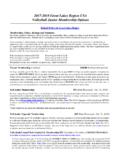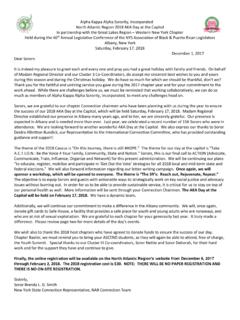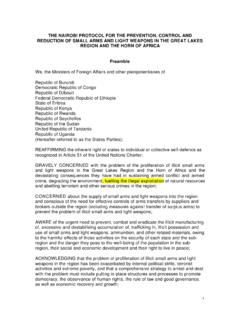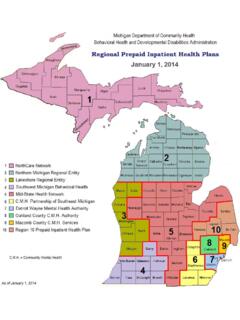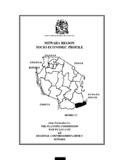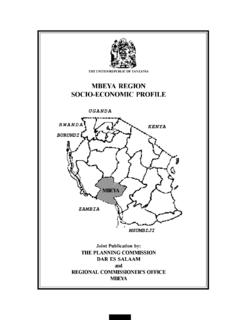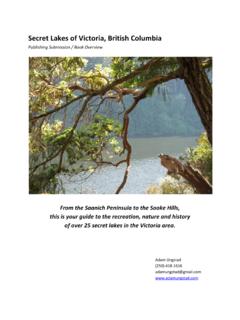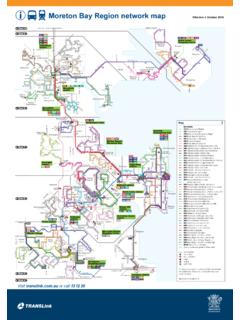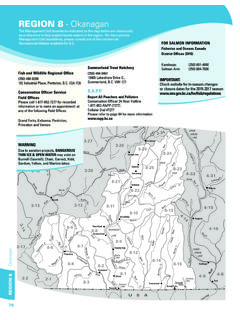Transcription of I U G L W L S . C R SUMMARY REPORT - IJC
1 IMPACTS ONUPPERGREATLAKESWATERLEVELS:ST. CLAIRRIVERFINALREPORT TO THEINTERNATIONALJOINTCOMMISSIONDECEMBER2 009 SUMMARYREPORTC atalogue number: E95-2/10-1-1-2009E-PDFISBN number:978-1-100-14159-6 REPORT CoverThe front cover shows two images of the St. Clair River prepared by the HydroSed2D model and Geographic InformationSystem rendering based on data collected by underwater multi-beam sonar surveys of the river bed in the summer of2008. The image to the right shows the channel morphology (depth and shape) from the mouth of the St. Clair Riverdownstream for about 10 kilometres ( miles).
2 The yellow areas indicate shallower areas and there is a transition toblue, the deepest areas in the river. The image to the left illustrates typical velocities and flow directions in this first bendof the river. Green reflects higher velocities, while blue indicates lower velocities. The background image of the cover, taken from an underwater video survey conducted in the summer of 2008 at depths of 12 to 14 metres (39 to 46 feet) shows the mostly gravel material found on the river bed in the upper reach of the St. Clair data collected from these types of surveys, and applying the best available models, scientists and engineers haveimproved our understanding of the hydraulics and morphology of the St.
3 Clair River and, in turn, the effects on the river ofnatural forces and recent human cover graphic credit: Dr. Syed Moin, Study Co-ManagerStudy Logo: John Nevin, Communications AdvisorPhoto Credits:p. 2:Jill Wingfield, International Upper Great Lakes Studyp. 7:Rich Kelly, KCO Pic s & Stuff LLCp. 11:Elaine Sterrett Isely, Annis Water Resources Institute, Grand Valley State Universityp. 15:International Upper Great Lakes Studyp. 19: United States Geological Survey, Michigan Water Science Centerp. 20:Trilby MacDonald, International Upper Great Lakes StudyiIMPACTS ONUPPERGREATLAKESWATERLEVELS: ST.
4 CLAIRRIVER SUMMARYREPORTIMPACTS ONUPPERGREATLAKESWATERLEVELS: ST. CLAIRRIVERI mpacts on Upper Great Lakes Water Levels: St. Clair Riveris the first of two major reports presenting the findings and recommendations of the bi-national International Upper Great Lakes Study (the Study). The Studyis a five-year investigation launched by the International Joint Commission in 2007. The St. Clair River part of the Study was established to address widespread concerns among governments at all levels, property owners and other interests about the long term economic and environmental effects of low water levels in the upper Great Lakes.
5 Scheduling of the St. Clair River part was accelerated by nearly one year to addressthese concerns on an urgent bi-national Study Board directed the work of nearly 100 scientists and engineers from governments, academia andthe private sector in both countries. The Study benefitted from a high level of independent peer review. The Study s Public Interest Advisory Group played a significant role in the Study s public information and engagement effort. A draft REPORT was made available for a 90-day public review and comment SUMMARY Reportprovides a synthesis of the Study s approach, findings and recommendations.
6 More infor-mation on the Study as well as the full scientific REPORT and its 34 scientific/technical reports are available at the Study swebsite: Study Board concluded that:1. The difference in water levels between lake Michigan-Huron and lake Erie has declined by about 23 centimetres (cm) (9 inches) between 1963 (following the last major navigational channel dredging in the St. Clair River) and 2006. 2. Three key factors contributed to this 23 cm (9 inches)change: A change in the conveyance(water-carrying capacity) of the St. Clair River accounts for an estimated 7 to 14 cm ( to inches) of the decline.
7 Glacial isostatic adjustment(the uneven shifts of the earth s crust since the last period of continentalglaciations ended) accounts for about 4 to 5 cm ( to inches) of the fall. Changes in climatic patternsaccount for 9 to 17 cm ( to inches); this factor has become even more important in recent years, accounting for an estimated 58 to 76 percent of the decline between1996 and the total decline is not as simple as adding up the estimates of the three contributing factors. These estimates are highly dependent on the choice of the specific time period being analyzed within the 1963-2006 ONUPPERGREATLAKESWATERLEVELS: ST.
8 CLAIRRIVER SUMMARYREPORTiiFORMOREINFORMATIONFor more information on the International Upper Great Lakes Study, or to view the Study s 34 scientific/technical reports,please visit the Study s website: can also be obtained by writing to either of the following addresses:International Joint CommissionInternational Joint Commission234 Laurier Ave. W. 2401 Pennsylvania Avenue, NW22nd FloorFourth FloorOttawa, ON Washington, DCCanada K1P 6K6 USA 204403. There has been no significant erosion of the channel along the length of the St. Clair River bed since at least 2000. Based on survey data collected in 1971, there appears to have been some enlargement of thechannel between 1971 and 2000.
9 However, the changes in the channel are within the error of the addition, there are issues regarding the reliability of the 1971 the basis of these findings and in accordance with its mandate, the Study Board recommends that: Remedial measures (to address past damages or adverse effects) not be undertaken in the St. Clair River at this time. The need for mitigative measures (to address possible future changes that might result in adverse effects) in theSt. Clair River be examined as part of the comprehensive assessment of the future effects of climate change onwater supplies in the upper Great Lakes basin in REPORT 2 of the Study, on lake Superior regulation, to be completed in Study Board also developed a set of recommendations addressing specific challenges in data collection,modelling and data management and coordination.
10 Implementation of these measures by governments willbe an important part of the legacy of the Study, helping provide water resource managers and policy makerswith the information they need to regulate the upper Great Lakes more effectively under a changing climateregime and for adaptive management THEEVER-CHANGINGGREATLAKES: OF IN THEUPPERGREATLAKES: WHATHAV EWELEARNED? ..13 THEST. ITTOGETHER: WHATDID THESTUDYFIND?.. IN THEUPPERGREATLAKES: THESTUDY LEGACY : WHEREDOWEGOFROMHERE? ..20iiiIMPACTS ONUPPERGREATLAKESWATERLEVELS: ST. CLAIRRIVER SUMMARYREPORT1 IMPACTS ONUPPERGREATLAKESWATERLEVELS: ST.
